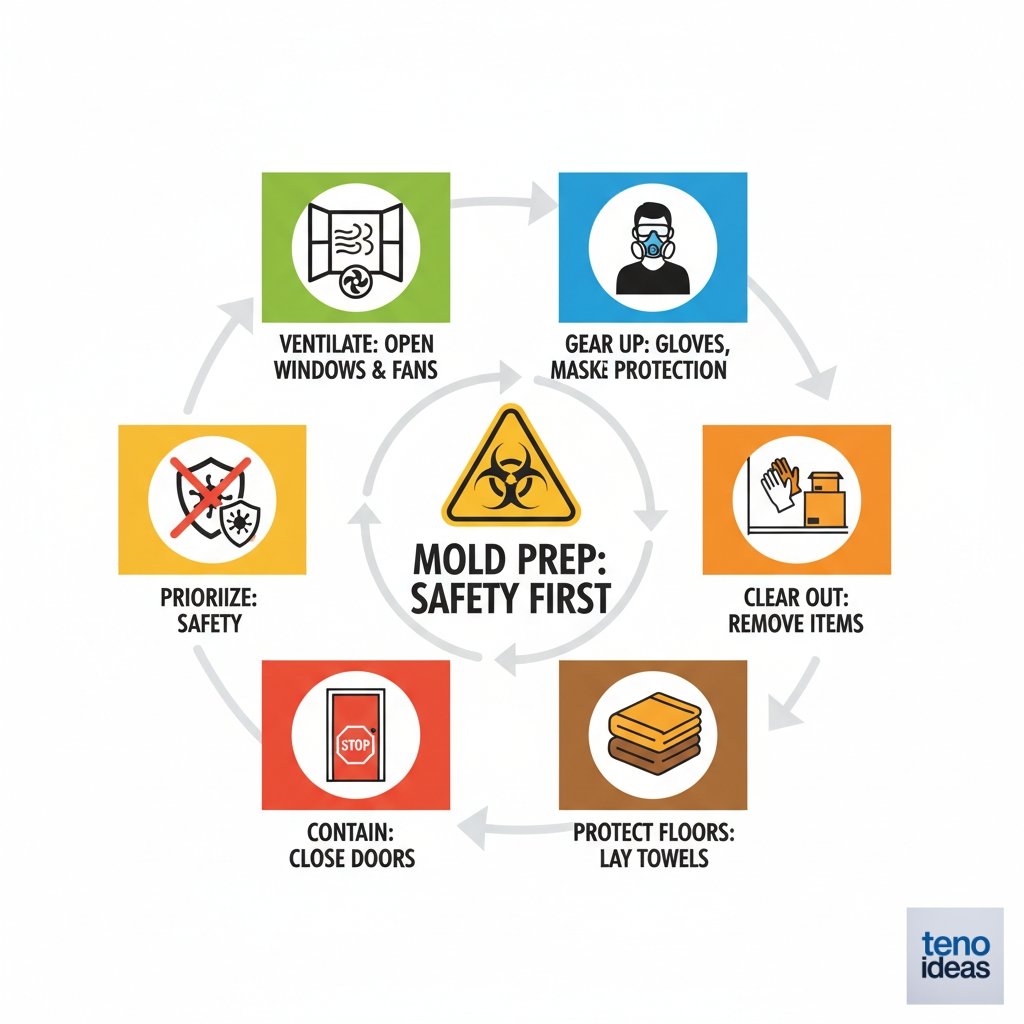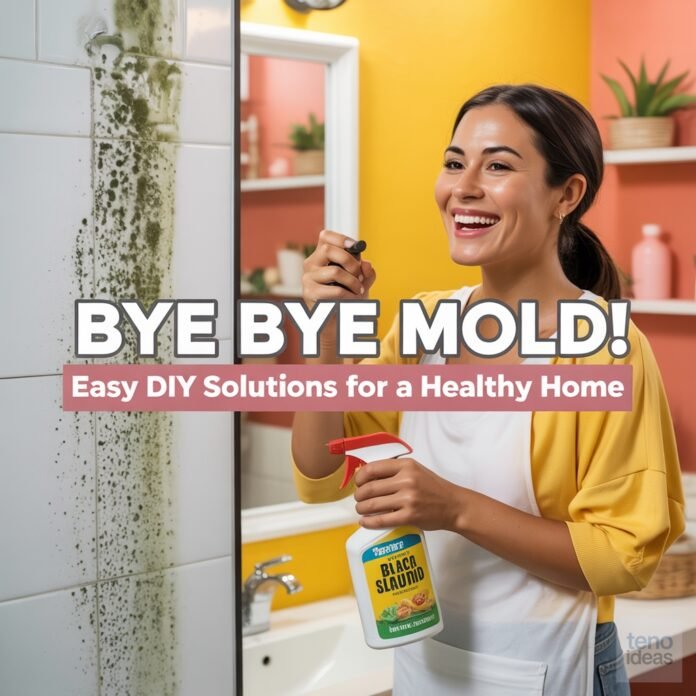Mold in your bathroom can be frustrating. It shows up in corners, around the tub, and on shower curtains. The good news? You can remove it safely and prevent it from coming back.
This guide will walk you through proven methods to eliminate bathroom mold. You’ll learn what causes it, how to clean it properly, and simple ways to stop future growth.
Most homeowners can handle bathroom mold removal with common household items. Let’s start with understanding why mold loves your bathroom so much.
Why Mold Grows in Bathrooms
Bathrooms create perfect conditions for mold growth. High humidity from hot showers combines with poor ventilation. Add in soap scum and organic matter, and mold has everything it needs.

Mold spores are everywhere. They float through air and land on surfaces. When they find moisture and food sources, they multiply quickly.
Common bathroom mold spots include:
- Shower tiles and grout
- Bathtub caulking
- Ceiling corners
- Around windows
- Behind toilets
- Shower curtains
What You’ll Need

Before starting, gather these supplies:
Cleaning supplies:
- White vinegar
- Baking soda
- Hydrogen peroxide (3%)
- Dish soap
- Old toothbrush
- Spray bottles
- Scrub brush
- Microfiber cloths
Safety gear:
- Rubber gloves
- Face mask
- Eye protection
- Old clothes
Optional items:
- Bleach (for tough cases)
- Commercial mold remover
- Steam cleaner
Step 1: Prepare the Area
Safety comes first when dealing with mold removal.

- Open windows and turn on exhaust fans
- Put on gloves, mask, and eye protection
- Remove items from the cleaning area
- Lay down old towels to protect floors
- Close doors to other rooms
Good ventilation prevents you from breathing mold spores during cleanup.
Step 2: Remove Surface Mold with Vinegar
White vinegar kills most mold types naturally and safely.
- Fill a spray bottle with undiluted white vinegar
- Spray affected areas thoroughly
- Let vinegar sit for 60 minutes
- Scrub with an old toothbrush or scrub brush
- Rinse with water
- Dry completely with clean cloths
Don’t dilute the vinegar. Its acidity works best at full strength.

Step 3: Tackle Stubborn Mold with Baking Soda Paste
Some mold needs extra scrubbing power.
- Mix 1/4 cup baking soda with enough water to make paste
- Apply paste to moldy areas
- Let sit for 10 minutes
- Scrub firmly with toothbrush
- Spray with vinegar over the paste (it will fizz)
- Wait 5 minutes
- Scrub again and rinse thoroughly
The paste provides abrasion while vinegar adds killing power.
Step 4: Use Hydrogen Peroxide for Deep Cleaning
Hydrogen peroxide reaches deeper into porous surfaces.
- Pour 3% hydrogen peroxide into spray bottle
- Spray moldy areas and let sit 10 minutes
- Scrub with brush
- Rinse and dry completely

Step 5: Clean Grout Lines Thoroughly
Grout holds onto mold because it’s porous.
- Make paste with baking soda and water
- Apply to grout lines with old toothbrush
- Let sit 5 minutes
- Scrub along grout lines firmly
- Spray with vinegar
- Scrub again after fizzing stops
- Rinse and dry
Replace grout that’s severely damaged by mold.
Step 6: Address Shower Curtains and Liners
Fabric curtains and plastic liners collect mold differently.
For fabric curtains:
- Remove and check care label
- Wash in hot water with 1/2 cup baking soda
- Add 1/2 cup vinegar to rinse cycle
- Air dry completely
For plastic liners:
- Remove from rings
- Soak in tub with vinegar solution
- Scrub with brush
- Rinse and air dry
Replace items that won’t come clean.
Step 7: Clean the Exhaust Fan

A dirty exhaust fan can’t remove humidity properly.
- Turn off power at breaker
- Remove fan cover
- Vacuum dust and debris
- Wipe with damp cloth
- Check if fan spins freely
- Replace cover and restore power
Clean exhaust fans every 6 months.
When to Use Bleach
Bleach kills mold but has downsides. Use it only when other methods fail.
- Mix 1 part bleach with 10 parts water
- Spray and let sit 15 minutes
- Scrub and rinse thoroughly
- Ensure excellent ventilation
- Never mix bleach with other cleaners
Bleach can damage surfaces and create harmful fumes.
Preventing Future Mold Growth
Prevention works better than removal.
Control humidity:
- Run exhaust fan during and after showers
- Open windows when possible
- Use a dehumidifier if needed
- Fix water leaks immediately
Regular cleaning:
- Wipe surfaces dry after use
- Clean weekly with mold-preventing products
- Wash shower curtains monthly
- Vacuum exhaust fan regularly
Improve airflow:
- Keep bathroom door open when not in use
- Add additional ventilation if needed
- Check that exhaust fan works properly
Signs You Need Professional Help
Some mold situations require experts:
- Mold covers more than 10 square feet
- It returns quickly after cleaning
- You smell musty odors but can’t find the source
- Anyone has health reactions to mold
- There’s been significant water damage
Don’t risk your health with extensive mold problems.
Natural vs. Commercial Products
Both options can work well for bathroom mold.
Natural products:
- Safer for family and pets
- Less harsh on surfaces
- Usually less expensive
- Take more time and effort
Commercial mold removers:
- Work faster on tough mold
- May contain stronger chemicals
- Cost more
- Can damage some surfaces
Choose based on your mold severity and preferences.
Maintaining a Mold-Free Bathroom
Consistency prevents major mold problems.
Create a simple routine:
- Wipe shower walls after each use
- Wash bath mats weekly
- Clean visible mold spots immediately
- Run exhaust fan for 30 minutes after showers
- Deep clean monthly
Small efforts prevent big problems later.
Take Action Against Bathroom Mold
Bathroom mold doesn’t have to be permanent. With the right approach, you can eliminate it and keep it from returning.
Start with the gentler methods like vinegar and baking soda. These handle most common mold problems safely. Move to stronger solutions only if needed.
Remember that prevention matters most. Good ventilation and regular cleaning stop mold before it starts. Your bathroom can stay clean and healthy with consistent care.
Take the first step today by gathering your cleaning supplies and tackling any visible mold spots.


